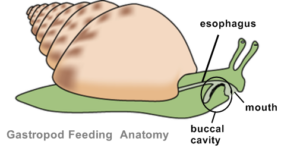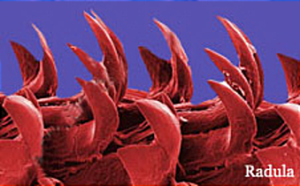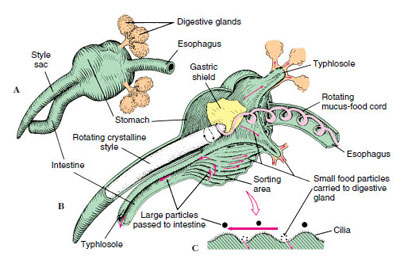
Snails Family gastropodia
Snail Menu
Snails
Snail Anatomy
Mud Dog Whelk (Mud Snail)
Moon Snails
Radula
Slipper Shell
Oyster Drill
Murex Snails

Radula specific to gastropods (from Latin radere – to scrape)
Most Mollusks (with the exception of bivalves) have a specialized feeding organ within the mouth called the radula.
 The mouth opens into a pocket-like buccal cavity.
The mouth opens into a pocket-like buccal cavity.
Inside this cavity is the radula sac which protects the mouth when the radula is not in use.
 Supporting the radula is a structure of cartilage called the odontophore.
Supporting the radula is a structure of cartilage called the odontophore.
Controlled by muscles, it is capable of being thrust forward and retracted in a rhythmic motion for feeding and retracted when finished.
 As for the radula itself, its ribbon-like structure is covered with many denticles (tiny teeth).
As for the radula itself, its ribbon-like structure is covered with many denticles (tiny teeth).
It is movable over the odontophore and is also controlled by muscles.
When not feeding
 Taking a closer look at the snail’s feeding mechanisms, we see that inside the mouth is a chamber called the radular sac.
Taking a closer look at the snail’s feeding mechanisms, we see that inside the mouth is a chamber called the radular sac.
When not feeding the radula is retracted into this chamber which protects the mouth from the sharp teeth of the radula.
The radula has hundreds to thousands of backwardly pointing chitinous teeth. The radula slides over a supporting structure of cartilage called the odontophore.
Both the radula and the odontophore can be moved forward (protracted) out of the mouth for feeding and brought back in (retracted) to bring in food or when finished eating.
This movement is accomplished by sets of protractor and retractor muscles as seen in the diagram to the left.
When feeding When a food source is located, the snail will begin to feed by first opening its mouth. The protractor muscles move the odontophore forward and the radula comes in contact with the food.
When a food source is located, the snail will begin to feed by first opening its mouth. The protractor muscles move the odontophore forward and the radula comes in contact with the food.
The retractor muscle sets bring the odontophore and the radula backwards and the teeth scrape the surface.
Food particles are moved up into the mouth as it closes.
This process is repeated as the snail continues to feed.
Fun Fact – Many carnivorous gastropods (moon snails, oyster drills and waved whelks) feed on shellfish in this manner.

 Moon snail victims
Moon snail victims
Once the hole is finished the snail inserts its proboscis into the clam to start feeding or if it pierces a vital organ and the clam dies the shell will open.
No Mercy
The image on the left is a hard clam. The image on the right is a Moon Snail.
Fun Fact – A countersink (symbol: ⌵) is a conical hole cut into a manufactured object.

